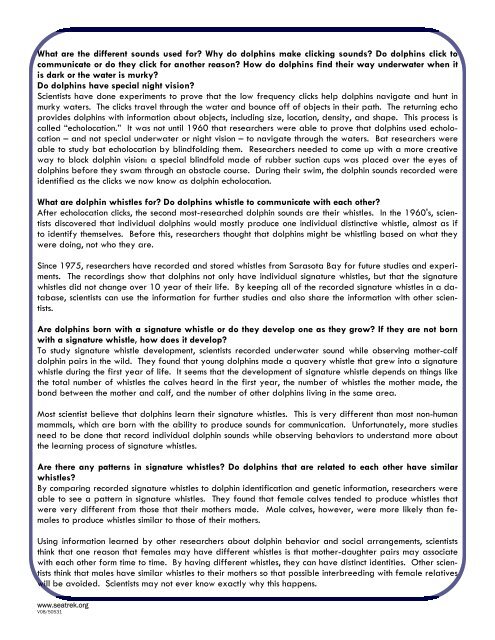LESSON 2 - SeaTrek Programs
LESSON 2 - SeaTrek Programs
LESSON 2 - SeaTrek Programs
You also want an ePaper? Increase the reach of your titles
YUMPU automatically turns print PDFs into web optimized ePapers that Google loves.
What are the different sounds used for? Why do dolphins make clicking sounds? Do dolphins click to<br />
communicate or do they click for another reason? How do dolphins find their way underwater when it<br />
is dark or the water is murky?<br />
Do dolphins have special night vision?<br />
Scientists have done experiments to prove that the low frequency clicks help dolphins navigate and hunt in<br />
murky waters. The clicks travel through the water and bounce off of objects in their path. The returning echo<br />
provides dolphins with information about objects, including size, location, density, and shape. This process is<br />
called “echolocation.” It was not until 1960 that researchers were able to prove that dolphins used echolocation<br />
– and not special underwater or night vision – to navigate through the waters. Bat researchers were<br />
able to study bat echolocation by blindfolding them. Researchers needed to come up with a more creative<br />
way to block dolphin vision: a special blindfold made of rubber suction cups was placed over the eyes of<br />
dolphins before they swam through an obstacle course. During their swim, the dolphin sounds recorded were<br />
identified as the clicks we now know as dolphin echolocation.<br />
What are dolphin whistles for? Do dolphins whistle to communicate with each other?<br />
After echolocation clicks, the second most-researched dolphin sounds are their whistles. In the 1960's, scientists<br />
discovered that individual dolphins would mostly produce one individual distinctive whistle, almost as if<br />
to identify themselves. Before this, researchers thought that dolphins might be whistling based on what they<br />
were doing, not who they are.<br />
Since 1975, researchers have recorded and stored whistles from Sarasota Bay for future studies and experiments.<br />
The recordings show that dolphins not only have individual signature whistles, but that the signature<br />
whistles did not change over 10 year of their life. By keeping all of the recorded signature whistles in a database,<br />
scientists can use the information for further studies and also share the information with other scientists.<br />
Are dolphins born with a signature whistle or do they develop one as they grow? If they are not born<br />
with a signature whistle, how does it develop?<br />
To study signature whistle development, scientists recorded underwater sound while observing mother-calf<br />
dolphin pairs in the wild. They found that young dolphins made a quavery whistle that grew into a signature<br />
whistle during the first year of life. It seems that the development of signature whistle depends on things like<br />
the total number of whistles the calves heard in the first year, the number of whistles the mother made, the<br />
bond between the mother and calf, and the number of other dolphins living in the same area.<br />
Most scientist believe that dolphins learn their signature whistles. This is very different than most non-human<br />
mammals, which are born with the ability to produce sounds for communication. Unfortunately, more studies<br />
need to be done that record individual dolphin sounds while observing behaviors to understand more about<br />
the learning process of signature whistles.<br />
Are there any patterns in signature whistles? Do dolphins that are related to each other have similar<br />
whistles?<br />
By comparing recorded signature whistles to dolphin identification and genetic information, researchers were<br />
able to see a pattern in signature whistles. They found that female calves tended to produce whistles that<br />
were very different from those that their mothers made. Male calves, however, were more likely than females<br />
to produce whistles similar to those of their mothers.<br />
Using information learned by other researchers about dolphin behavior and social arrangements, scientists<br />
think that one reason that females may have different whistles is that mother-daughter pairs may associate<br />
with each other form time to time. By having different whistles, they can have distinct identities. Other scientists<br />
think that males have similar whistles to their mothers so that possible interbreeding with female relatives<br />
will be avoided. Scientists may not ever know exactly why this happens.<br />
www.seatrek.org<br />
V08/50531





